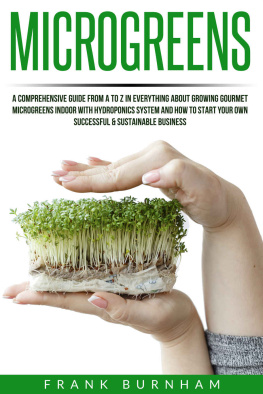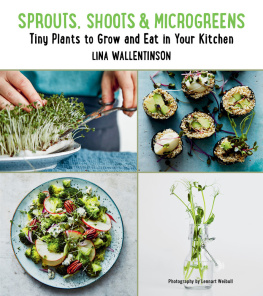Microgreens
A Guide to Growing Nutrient-Packed Greens
Eric Franks and Jasmine Richardson
Photographs by Margaux Gibbons

Microgreens
A Guide to Growing Nutrient-Packed Greens
Digital Edition v1.0
Text 2009 Eric Franks and Jasmine Richardson
Photographs 2009 Margaux Gibbons except the following:
Sara Remington, photos of trays of microgreens in Foreword; in Finding a Good Spot to Grow section and at end of How-to-Grow chapter; first two photos in Individual crops chapter; and photo of Erik Franks and Jasmine Richardson in Recipes chapter.
Jasmine Richardson, photo of Four Seasons Farm in Health and Microgreens chapter
Craig Lovell, photo of broccoli field in Health and Microgreens chapter
Ariel Williams, sketches of compost receptacle and tumbler in Composting chapter
All rights reserved. No part of this book may be reproduced by any means whatsoever without written permission from the publisher, except brief portions quoted for purpose of review.
Gibbs Smith, Publisher
PO Box 667
Layton, UT 84041
Orders: 1.800.835.4993
www.gibbs-smith.com
Library of Congress Catalog-in-Publishing Data
ISBN-13: 978-1-4236-0364-1
ISBN-10: 1-4236-0364-8
1. Greens, Edible. 2. Cookery (Greens) I. Richardson, Jasmine. II. Title.
SB339.F73 2009
635.5dc22
2008030670
To our son, Haven
He is the light of our lives and represents a bright future for this world. He came into our lives while writing this book and has expanded our hearts beyond belief.
We also dedicate this book to all of the farmers that have taken the time to share their wisdom so that the craft of traditional farming can continue and flourish. Thank you to Tim and Fabienne Rapsey, Eliot Coleman, Barbara Damrosch, Siri Beringer, Paul Birdsall, and all of the other fine people who have helped us along the way.
A special thanks to Jennifer Gillespie for the guidance and inspiration she has given us over the years.
Lastly, we have newfound gratitude for our parents as we start our journey with Haven. Our lives would not be possible without the love and support that they have given us.
Thank you.
Foreword
Over the years, quite a number of young people have worked with us here on the farm. They arrive bright-eyed and eager to learn more about farming and we try not to disappoint that expectation. Over the course of all four seasons, they help us to produce and market some 35 different vegetable crops plus numerous fruits, herbs, and flowers. When they depart after a year or two, they scatter to the corners of the earth, some to pursue new, untried interests, but many to carve out a career in the broad world of food production. Jasmine and Eric are members of the latter brigade. They were great workers and became staunch friends. It gives us great joy to see them taking their place in the ever-growing ranks of small-scale, earth-friendly farmers. And we heartily celebrate their skill and expertise in the production of that most exquisite of salad ingredientsmicrogreens.
From the moment a seed sprouts, new life and new life-giving forces are being created. The quality of the soil and the care of the grower are the guiding hands. At every step in its life cycle the plant offers different culinary possibilities to the imaginative cook, possibilities that are becoming increasingly recognized in kitchens everywhere. It takes a great deal of knowledge of soils and irrigation and attention to detail to nurture those seeds to the desired stage of growth, and then much careful thinking and planning to harvest, pack, and market them at a sufficient profit to make your living farming. Three cheers to Jasmine and Eric for their success in pursuing this goal and then presenting it so clearly and thoroughly in this book for others to follow, both farmers and home gardeners alike. Bon appetit!
Eliot Coleman and Barbara Damrosch
Harborside, Maine
Introduction
We met on a small farm in rural Pennsylvania. Linked by our love for food and small-scale agriculture, we traveled the country working on diversified farms. We studied market gardening, farming with draft horses, sustainable animal husbandry, and intensive four-season greenhouse production.
During our travels and training, we learned about microgreens. We began growing them in the dead of winter at Barbara Damroschs and Eliot Colemans Four Season Farm on the tip of Cape Rosier in Harborside, Maine. One of the philosophies behind their farm was farming on the backside of the calendar, so we suited up in our long johns for a long Maine winter. While we focused on the winter salad production, we also experimented with growing microgreens as something new and different to offer our local chefs. As the season progressed and spring set in, the responsibilities of the farm took us away from this niche. Looking back, it seemed as if this short stint would be the only time that we would grow these little beauties.
After we left the farm, we peeled off the long johns and moved to coastal California, beginning the search for land to start our own farm. We moved to Big Sur, where we had family and friends, and although beautiful, it is not the ideal place to find farmland. However, it served as the perfect home base for starting our hunt. We found a place to rent on the side of a mountain with less than one hundredth of an acre of flat ground. At first sight it didnt look like a good place to grow anything, and by now we had been away from life on the farm for several months. We missed getting our hands in the earth. Remembering the small amount of space microgreens required, we started a few trays for ourselves on our porch.
Slowly, we began bringing samples down to local restaurants. As demand grew, we grew with it. Our porch quickly went from a place to sit and relax in the sun to a greens-growing haven. Suddenly, we found ourselves spending all of our free time honing and refining our new craft. We experimented with different varieties, exploring the never-ending variation in flavor and appearance while catering to the local chefs. We did many trials on soil, seed, and water pH to learn what each crop preferred. We became fully immersed in the world of microgreens.

Struck by their nutritional potency, we started thinking of the difference they could make not only in our community but in others as well. We loved the beauty they brought to the dishes created by chefs but wished we could get these greens to the broader public and in larger quantities. Without requiring a large financial investment or substantial previous knowledge, microgreens could provide a stepping-stone on the path to nutritional independence. Communities around the world could easily nourish themselves while enriching the land around them, adding fertility for future generations.
As we shared the health benefits of microgreens and their accessibility with others, we were surprised by the universal excitement everyone felt about them. Growing their own microgreens seemed like something they could easily do and even enjoy. We worked on simplifying our system so that we could share this knowledge with even more people.
A common limitation many face when trying to grow their own food is the commitment it requires to take on a garden. Just as spring and summer are the busiest times of the garden, they are also busy times in peoples lives. We are often taken away from our homes during the summer months, leaving a well-intentioned garden as a burden or forgotten responsibility. Home gardens are often filled with beautiful produce with no one but the birds to eat it. Growing your own microgreens allows you to stop and start whenever you want, leaving you with less of a commitment to attend tothus allowing more time, flexibility, and ease for your life.














